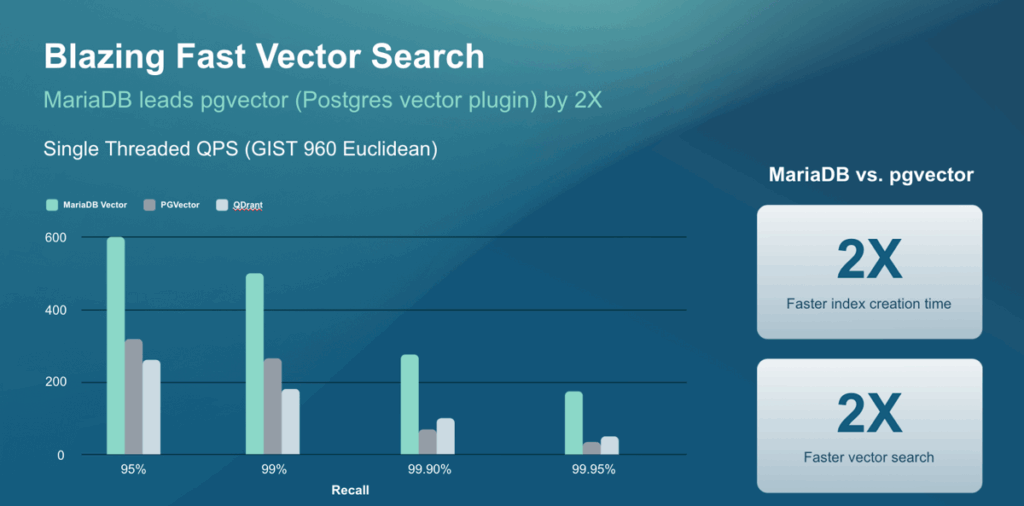The rise of artificial intelligence (AI) and machine learning (ML) has created a demand for databases that can efficiently handle both structured and unstructured data. MariaDB Enterprise Platform meets this demand by integrating vector search directly into its core database engine. This unlocks powerful new capabilities, allowing you to build sophisticated AI-driven applications using Retrieval-Augmented Generation (RAG) systems, semantic search, and recommendation engines.
By eliminating the need for separate vector databases, MariaDB streamlines your data infrastructure and allows you to leverage the synergy between traditional SQL operations and vector embeddings. By consolidating vector and relational data management, MariaDB Enterprise Platform simplifies development, enhances performance, and reduces costs, making it a cost-effective solution for organizations looking to harness the full potential of AI.
Achieve Superior Relevance with Hybrid Search
Deliver exceptionally accurate results by combining the best of two search methods. Hybrid search merges the keyword precision of full-text search with the similarity-based matching of vector search. MariaDB then uses Reciprocal Rank Fusion (RRF) to intelligently rank and unify the results, ensuring your users find exactly what they’re looking for, faster.
Simplified Data Stack for Vector Management
Streamline your data infrastructure by eliminating separate vector databases. MariaDB’s native support for vector search allows you to manage relational data and vector embeddings in one unified environment, reducing complexity, operational overhead and data synchronization headaches.
High Performance for Demanding AI Workloads
Deliver high-performance vector search with fast, high-QPS similarity searches for your AI applications. By handling vector workloads natively, MariaDB ensures optimal performance and seamless integration without requiring specialized external databases.
Seamless Integration with Relational Data
Combine the power of vector search with your existing relational data. Perform complex hybrid queries that leverage both data types to uncover deeper insights. For example, query for visually similar products that also match structured criteria like price and inventory, all within a single SQL statement.
Cost-Effective Vector Search with MariaDB
Avoid the costs and complexity of separate vector databases. MariaDB Enterprise Platform lets you leverage your existing infrastructure for integrated vector search, reducing operational overhead and simplifying administration. Ditch the database-polyglot for a single, powerful solution.

MariaDB vs. pgvector
Vector Search Performance Benchmark
Small Datum LLC recently conducted rigorous benchmarks comparing MariaDB’s integrated vector search functionality with pgvector, a popular extension for PostgreSQL. The results offer compelling insights into the speed, efficiency and ease of use of MariaDB’s vector search compared to pgvector.

High QPS (queries per second)
MariaDB consistently outperforms pgvector, delivering up to twice the QPS for a given recall target.
Fast index creation time
MariaDB is significantly faster, requiring less time to build an index while achieving comparable or superior recall (the percentage of truly relevant results, i.e., “true nearest neighbors,” that are returned by a query).
Ease of tuning
MariaDB simplifies the tuning process by eliminating the need for complex parameter configurations, which are required by pgvector.

Get Started with Vector Search
Featured Resources
VIDEO
Introduction to Vector Embeddings and Vector Search
WEBINAR
Introduction to building GenAI applications, LLMs, Vector Embedded Search and more
BLOG
Transforming Databases for the AI Era: The Vector Revolution
